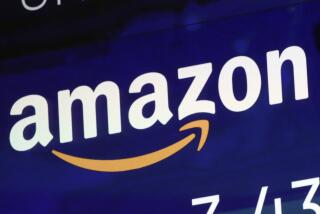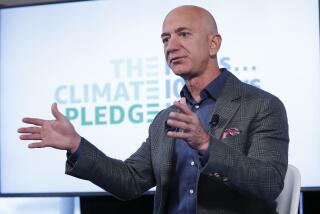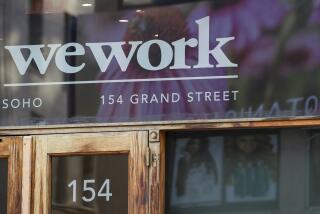Amazon.com Challenges Analyst Report
- Share via
NEW YORK — Amazon.com Inc. on Tuesday slammed a new report from one of its harshest critics, a Lehman Bros. analyst who warned that the Internet retailer faces a “creditor squeeze” in the second half of 2001 and urged that investors avoid its convertible bonds.
“Obviously you can’t take this seriously,” said Bill Curry, a spokesman for Seattle-based Amazon.com, about the report issued early Tuesday by Ravi Suria, Lehman’s vice president of convertible strategy.
“He said we would be out of cash by the end of 2000, and he missed by $1.1 billion,” Curry said. “It’s a silly report that’s chock-full of errors.”
Suria declined to comment beyond the report.
After falling Tuesday to $13.56, their 52-week low, Amazon.com shares rallied to close at $15.81, up $1.38, or 9.5%, on Nasdaq. They are down 81% from their 52-week high of $84.
Amazon.com, which sells everything from books to barbecues, said last week it will cut 1,300 jobs, or 15% of its work force, in a bid to turn profitable by year-end. It also said it will stop selling unprofitable items.
Several analysts have questioned how easily Amazon.com can turn profitable as its projected revenue growth slows to 20% to 30% in 2001 from 44% in 2000.
Suria, who since last June has urged investors to avoid Amazon.com’s convertible bonds, said in his report it is now most appropriate to analyze Amazon.com by the “going concern” standard that auditors use to assess a company when there is “substantial doubt” about its ability to keep running.
By year’s end, he said, Amazon.com will have negative $38 million of liquidity, or working capital. That is the amount by which liabilities exceed assets.
At the end of 2000, he said, Amazon.com had only $386 million of liquidity, not the $1.1 billion the company reported. That reflects the difference between its $1.36 billion of assets and $975 million of liabilities. A year ago, Suria said, working capital was $700 million.
“Working capital will continue to decline every quarter for the foreseeable future until the company starts generating enough cash profits to cover interest payments or receives a capital infusion,” he added.
More to Read
Inside the business of entertainment
The Wide Shot brings you news, analysis and insights on everything from streaming wars to production — and what it all means for the future.
You may occasionally receive promotional content from the Los Angeles Times.










